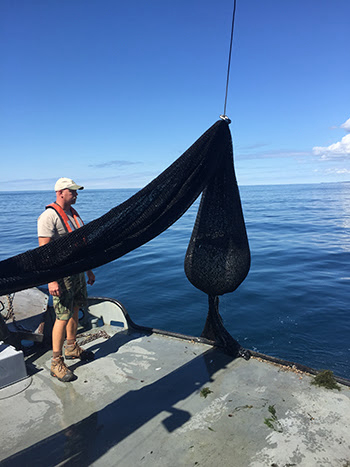MI DNR begins 47th annual Saginaw Bay fish community survey

R/V Tanner in motion on Lake Huron
This month the Michigan Department of Natural Resources is conducting its 47th annual survey of the Saginaw Bay fish community. The survey, now under way, includes both trawling and gillnetting and will determine the abundance and health of fish populations in the bay.
“The timing of late summer or early fall allows us to assess how much reproduction has taken place for the year, as well as the overall abundance of older age groups,” said Dave Fielder, DNR fisheries research biologist. “The use of the same methods each year allows us to detect population changes in each species.”
This survey annually produces data to gauge the effects of fisheries management actions and invasive species on bay fish populations. While the DNR does other work in Saginaw Bay – such as walleye tagging projects, creel surveys and habitat work – this fish community study is the department’s primary look at the status of the fish populations.
This year’s study marks the second year of changed harvest regulations, first implemented in October 2015. Those changes increased the daily possession limit of walleye from five to eight fish in the bay and lowered the minimum length limit from 15 inches to 13 inches. It also lowered the daily possession limit of yellow perch from 50 to 25 fish. These changes were intended to make for more complete use of the recovered walleye population and promote yellow perch survival. The results of the survey will help determine if additional regulation changes are needed.
Long-term surveys such as this one are critical to understanding fish communities and how they are changing. It takes about two to three weeks and two research vessels – the R/V Tanner out of Alpena and the R/V Channel Cat out of Harrison Township – to complete the work.
“It will be a few months before we have the full results of this survey since there is a lot of follow-up lab work to do, such as aging the fish we sampled,” Fielder said. “The data we collect will be analyzed and shared with our fisheries managers and stakeholders prior to the 2018 fishing season so that any needed adjustments to existing regulations can be implemented.”





